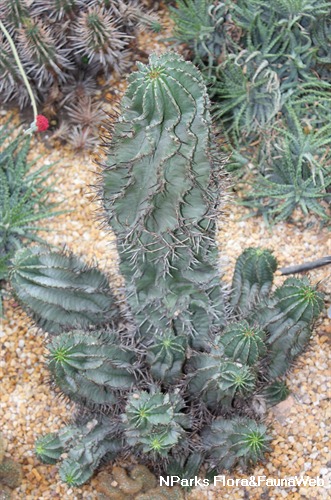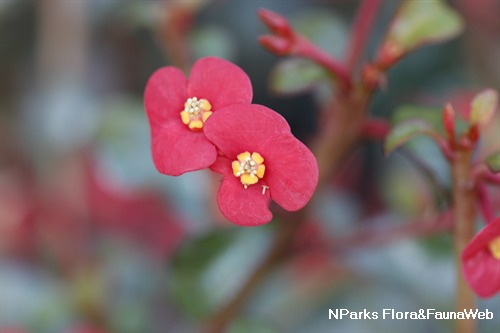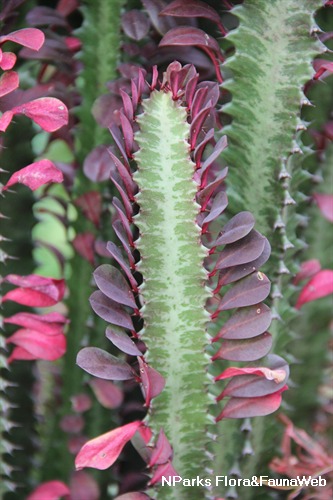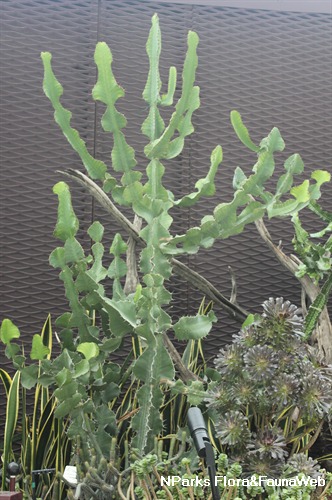
Name
Classifications and Characteristics
| Plant Division | Angiosperms (Flowering Seed Plants) (Dicotyledon) |
|---|---|
| Plant Growth Form | Shrub |
| Lifespan (in Singapore) | Perennial |
| Mode of Nutrition | Autotrophic |
| Plant Shape | Columnar |
| Maximum Height | 1 m to 1.5 m |
| Maximum Plant Spread / Crown Width | 0.1 m to 0.5 m |
Biogeography
| Native Distribution | South Africa |
|---|---|
| Native Habitat | Terrestrial |
| Preferred Climate Zone | Desert / Arid |
| Local Conservation Status | Non-native |
| CITES Protection | True (Appendix II) |
Description and Ethnobotany
| Growth Form | Clump-forming succulent up to 1-1.5 m tall. |
|---|---|
| Stems | Erect, bluish green stem is cylindrical (75 cm tall, 10-15 cm wide) and composed of 10-20 flattened ribs which are often wavy. Each rib is armed with orange or grey, spine-like structures (4 cm long) which were originally stalks that bore the cyathia (the inflorescence), but later dried and hardened. |
| Flowers | Like other Euphorbia species, it produces a cyathium (plural: cyathia, a tiny inflorescence that resembles a single flower, having male and female flowers surrounded by petal-like bracts). The green and yellow cyathia are produced singly along the ribs of the stem. |
| Cultivation | This species usually does not have any disease problems, but is sometimes attacked by mealy bugs. It should be fed with a low nitrogen liquid fertiliser. This species reaches a maximum height of 1-1.5 m after 10-20 years. |
| Etymology | This species is often known by its synonym 'Euphorbia horrida'. The horrida specific epithet means spiny. |
Landscaping Features
| Desirable Plant Features | Ornamental Stems |
|---|---|
| Landscape Uses | Container Planting |
| Thematic Landscaping | Rockery / Desert Garden |
| Usage Hazard - Cons | Spines/Thorns - Stem/Branch, Toxic Upon Ingestion, Irritant - Sap |
| Usage Hazard - Cons Remarks | All parts of the plant are very toxic. The sap may irritate the skin and eyes. |
| Plant & Rootzone Preference or Tolerance Remarks | This species grows best in a well-draining mixture of loamy compost and sand. |
Plant Care and Propagation
| Light Preference | Full Sun |
|---|---|
| Water Preference | Little Water |
| Rootzone Tolerance | Drought Tolerant, Well-Drained Soils, Fertile Loamy Soils |
| Maintenance Requirements | Low |
| Propagation Method | Seed, Sucker |
Floral (Angiosperm)
| Flower & Plant Sexuality | Unisexual Flowers |
| Flower Colour(s) | Green, Yellow / Golden |
|---|---|
| Flower Grouping | Cluster / Inflorescence |
| Inflorescence Type | Cyathium |
Image Repository
Others
| Master ID | 31827 |
|---|---|
| Species ID | 6227 |
| Flora Disclaimer | The information in this website has been compiled from reliable sources, such as reference works on medicinal plants. It is not a substitute for medical advice or treatment and NParks does not purport to provide any medical advice. Readers should always consult his/her physician before using or consuming a plant for medicinal purposes. |








